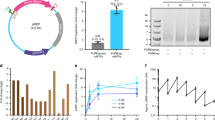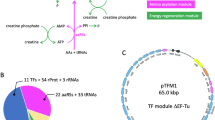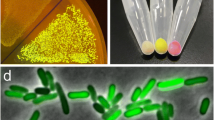Summary
An artificial gene encoding the Escherichia coli translational initiation factor IF1 was synthesized based on the primary structure (71 amino acid residues) of the protein. Codons for individual amino acids were selected on the basis of the preferred codon usage found in the structural genes for the initiation factor IF2 of E. coli and Bacillus stearothermophilus, both of which can be expressed at high levels in E. coli cells. We gave the IF1 gene a modular structure by introducing specific restriction enzyme sites into the sequence, resulting in units of three to ten codons. This was conceived to facilitate site-directed mutagenesis of the gene and thus to obtain IF1 with specific amino acid alterations at desired positions. The IF1 gene was assembled by shot-gun ligation of 9 synthetic oligodeoxyri-bonucleotides ranging in size from 31 to 65 nucleotides and cloned into an expression vector to place the gene under the control of an inducible promoter. Upon induction, E. coli cells harbouring the artificial gene were found to produce large amounts (≥60 mg/100 g cells) of a protein indistinguishable from natural IF1 in both chemecal and biological properties.
Similar content being viewed by others
References
Brombach M, Pon CL (1987) The unusual translational initiation codon AUU limits the expression of the infC (initiation factor IF3) gene of Escherichia coli. Mol Gen Genet 208:94–100
Brombach M, Gualerzi CO, Nakamura Y, Pon CL (1986) Molecular cloning and sequence of the Bacillus stearothermophilus translational initiation factor IF2 gene. Mol Gen Genet 205:97–102
Brown EL, Belagaje R, Ryan MJ, Khorana HG (1979) Chemical synthesis and cloning of a tyrosine tRNA gene. Methods Enzymol 68:109–151
Bruhns J (1980) Struktur-Funktionsbeziehungen in den Initiations-faktoren IF1 and IF3 aus E. coli. Einfluß der Tyrosine auf die ribosomale Bindung und die biologische Aktivität. Doctoral Thesis, Technical University Berlin
Canonaco MA, Calogero RA, Gualerzi CO (1986) Mechanism of translational initiation in prokaryotes. Evidence for a direct effect of IF2 on the activity of the 30S ribosomal subunit. FEBS Lett 207:198–204
Fritz H-J, Belagaje R, Brown EL, Fritz RH, Jones RA, Lees RG, Khorana HG (1978) High-pressure liquid chromatography in polynucleotide synthesis. Biochemistry 17:1257–1267
Grifantini R (1986) Identificazione dell'istidina essenziale per l'attivita del fattore d'inizio della sintesi proteica di E. coli IF1. Doctoral Thesis, University of Camerino
Grunberg-Manago M (1980) Initiation of protein synthesis as seen in 1979. In: Chambliss G, Craven GR, Davies J, Davis K, Kahan L, Nomura M (eds) Ribosomes, structure, function and genetics. University Park Press, Baltimore, Md, pp 445–477
Gualerzi C, Pon CL (1981) Protein biosynthesis in prokaryotic cells: mechanism of 30S initiation complex formation in E. coli. In: Balaban M (ed) Structural aspects of recognition and assembly in biological macromolecules, vol 2. ISS Press, Rehovot, pp 805–826
Gualerzi C, Risuleo G, Pon C (1977) Initial rate kinetic analysis of the mechanism of initiation complex formation and the role of initiation factor IF3. Biochemistry 16:1684–1689
Gualerzi C, Pon CL, Pawlik RT, Canonaco MA, Paci M, Winter-meyer W (1986) Role of the initiation factors in E. coli translational initiation. In: Hardesty B, Kramer G (eds) Structure, function and genetics of ribosomes. Springer, New York, pp 621–641
Lee-Huang S, Sillero MAG, Ochoa S (1971) Isolation and properties of crystalline initiation factor IF1 from E. coli ribosomes. Eur J Biochem 18:536–543
O'Farrell PH, Kutter E, Nakanishi M (1980) A restriction map of the bacteriophage T4 genome. Mol Gen Genet 179:421–435
Ohyama K, Fukuzawa H, Kohchit T, Shirai H, Sano T, Sano S, Umesone K, Shiki Y, Takeuchi M, Chang Z, Aota S, Inokuchi H, Ozaki H (1986) Chloroplast gene organization deduced from complete sequence of liverwort Marcantia polymorpha chloroplast DNA. Nature 322:572–574
Paci M, Pon CL, Gualerzi C (1983) High resolution 1H NMR study on the interaction between initiation factor IF1 and 30S ribosomal subunits. EMBO J 2:521–526
Pawlik RT, Littlechild J, Pon CL, Gualerzi C (1981) Purification and properties of E. coli initiation factors. Biochem Int 2:421–428
Pon CL, Gualerzi CO (1984) Mechanism of protein biosynthesis in prokaryotic cells. Effect of initiation factor IF1 on the initial rate of 30S initiation complex formation. FEBS Lett 175:203–207
Pon CL, Wittmann-Liebold B, Gualerzi C (1979) Structure-function relationship in E. coli initiation factors: II. elucidation of the primary structure of IF1. FEBS Lett 101:157–160
Remaut E, Stanssens P, Fiers W (1981) Plasmid vectors for high efficiency expression controlled by the PL promoter of coliphage lambda. Gene 15:81–93
Sacerdot C, Dessen P, Hershey JWB, Plumbridge JA, Grunberg-Manago M (1984) Sequence of the IF2 gene: unusual protein features and homologies with elongation factors. Proc Natl Acad Sci USA 81:7787–7791
Sanger F, Nicklen S, Coulson AR (1977) DNA sequencing with chain-terminating inhibitors. Proc Natl Acad Sci USA 74:5463–5467
Scherer GF, Walkinshaw MD, Arnott S, Morré DJ (1980) The ribosome binding sites recognized by E. coli ribosomes have regions with signal character in both the leader and protein coding segments. Nucleic Acids Res 8:3895–3907
Shine J, Dalgarno L (1974) The 3′-terminal sequence of E. coli 16S ribosomal RNA: complementarity to nonsense triplets and ribosome binding sites. Proc Natl Acad Sci USA 71:1342–1346
Sijben-Müller G, Hallick RB, Alt J, Westhoff P, Herrmann RG (1986) Spinach plastid genes coding for initiation factor IF1, ribosomal protein S11 and RNA polymerase α-subunit. Nucleic Acids Res 14:1029–1044
Smith AJH (1980) DNA sequence analysis by primed synthesis. Methods Enzymol 65:560–580
Smith J, Look E, Fotheringham I, Pheby S, Derbeyshire R, Eaten MAW, Doel M, Lilley DMJ, Pardon JF, Patel T, Lewis H, Bell LD (1982) Chemical synthesis and cloning of a gene for human β-urogastrone. Nucleic acids Res 10:4467–4482
Sproat BS, Gait MJ (1985) Chemical synthesis of a gene for somatomedin C. Nucleic Acids Res 13:2959–2977
Swank RT, Munkres KD (1971) Molecular weight analysis of oligopeptides by electrophoresis in polyacrylamide gel with sodium dodecyl sulfate. Anal Biochem 39:462–477
Wintermeyer W, Gualerzi C (1983) Effect of E. coli initiation factors on the kinetics of NAcPhe-tRNAPhe binding to 30S ribosomal subunits. A fluorescence stopped-flow study. Biochemistry 22:690–694
Author information
Authors and Affiliations
Additional information
Communicated by K. Isono
Rights and permissions
About this article
Cite this article
Calogero, R.A., Pon, C.L. & Gualerzi, C.O. Chemical synthesis and in vivo hyperexpression of a modular gene coding for Escherichia coli translational initiation factor IF1. Mole Gen Genet 208, 63–69 (1987). https://doi.org/10.1007/BF00330423
Received:
Issue Date:
DOI: https://doi.org/10.1007/BF00330423




